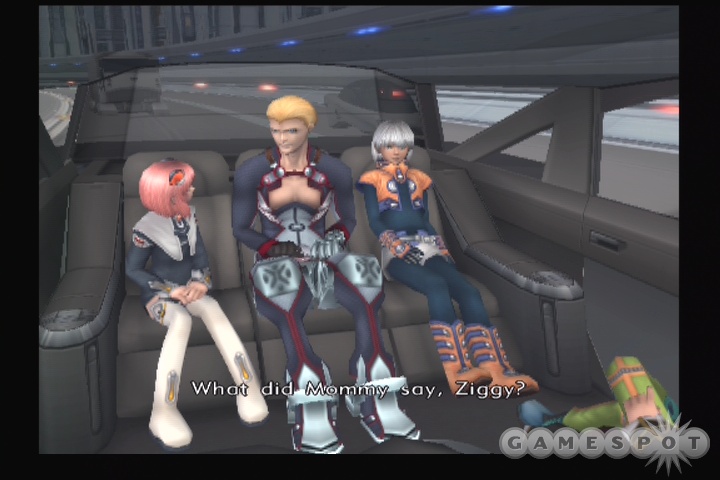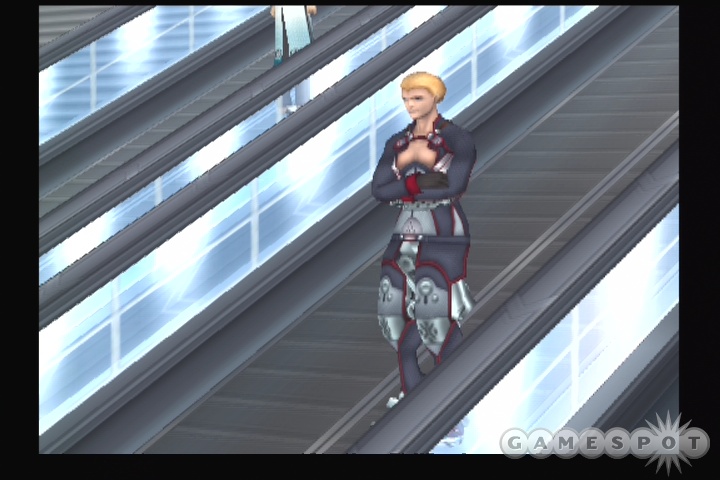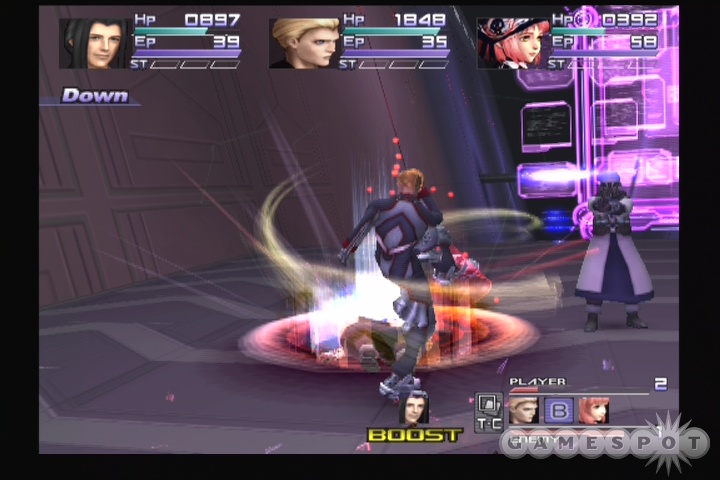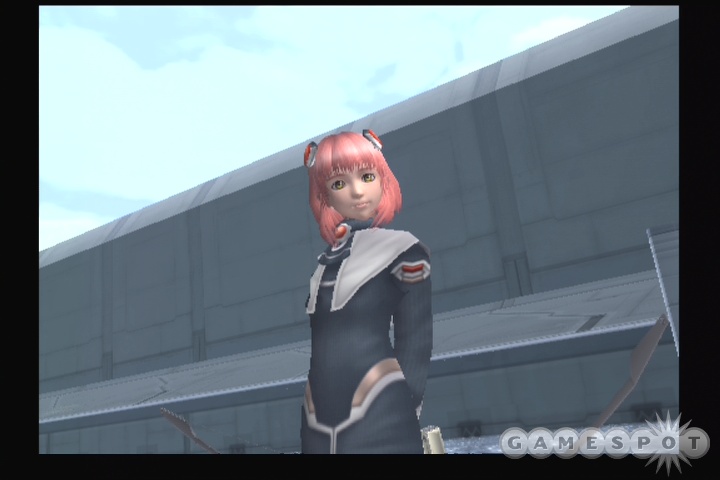The original Xenosaga broke new ground in the staid field of role-playing game narrative upon its release with its singular, intense devotion to storytelling through cinematic sequences and its memorable cast of characters. Episode II: Jenseits von Gut und Bose ("Beyond Good and Evil") shares the same spirit as its dramatic predecessor, incorporating new factions, new intrigues, and new faces into a universe already teeming with complex history. The series' momentum adopts a more leisurely pace, however, taking the time to more fully develop the characters and their relationships, to both each other and to the danger represented by the strange artifact called the Zohar. At the same time, this game is shorter than its prequel and features a much more simplified, less robust character advancement system. However, improvements to the game's turn-based combat engine, graphics, and its still-captivating plot ensure that fans of story-driven role-playing games and the Xenosaga series itself will still find much to appreciate about Episode II.

A flashback sequence starts things off, with the soft-spoken, enigmatic young man named Chaos accepting a mission alongside a serious-faced Realian (android) named Canaan. They're being sent to the surface of Miltia, a world being wracked with destruction due to the near totality of the Realian population suddenly going berserk. Upon reaching the surface, they come into contact with what appears to be the only other individual still possession of his wits--Federation officer Jin Uzuki. Together, they set off to find their objectives: the URTVs, specially bioengineered teenaged boys with the power to stop a deadly form of energy by negating it. Matters start to heat up, and just when things are getting interesting, the story shifts to the present, and we rejoin the intrepid crew of Shion, KOS-MOS, MOMO, Ziggy, Jr., and their friends as they land on Second Miltia.
There are a number of factions jousting for advantage in the game, and the advantage they're positioning for is control of the original Zohar, the mysterious artifact that was sealed away on Old Miltia several years ago. The grim swordsman Margulis and his employers come into the fore, as well as the smiling young Wilhelm with his powerful associates. There are new characters on the side of "good" as well: Shion's brother Jin Uzuki finally makes his appearance as a master of Japanese swordsmanship that can't seem to decide on a steady job; and Canaan, the aloof Realian, also comes along for the ride. Much of the storyline explores and unmasks the relationships between various characters, such as the storied past of Jr. and Albedo, as well as some new revelations about MOMO and her creation, the source of tension between Shion and her brother, and so forth. Much of this game is character-driven, and so the events in Episode II seem mostly concentrated on developing these individuals and their relationships even further. Mind you, this isn't a bad thing--the rich cast is what drives this series, so the indulgence is justified.

When wandering through Episode II's slick, sci-fi future, you'll still encounter enemies as entities visible on the screen. You can either attempt to avoid, engage, or ensnare them in a trap that you can activate nearby in some cases. You'll have to be ready to fight more often than not, as your foes are rarely parked with enough wiggle room to truly bypass them. Fortunately, the battle system has gone through some refinement, affording you a wide spread of options that you can use to fell even the most difficult of foes.
Your party members now unleash strikes on enemies according to a specific "zone" on that enemy, such as zone A, B, or C, as well as their ether "magic" attacks. All zones will do some damage, but each enemy has "weak" zones which, if they are struck in a certain order, will inflict break status on them. Breaking an enemy causes that attack to do greater damage, and if you use the boost command to give your party members initiative, you can chain attacks on vulnerable opponents for bonuses. Also, enemies in break can be hit into the air or onto the ground, at which point they can be flayed by party attacks for even greater injury. Each turn taken in battle tends to have a random attribute associated with it, so you can try and time your attacks for critical bars to get bonus damage or to get extra skill points. This sounds like it would make battles almost trivial, but the enemies on offer in Xenosaga Episode II are of a hardy sort. Mindless button mashing will likely get you a dead party of characters, particularly with bosses; careful usage of boosting and breaking are the keys to success. But that's not all.
Your characters can also store up to three extra attacks by "stocking" their turns in battle. Someone who gains stock cannot act in that same turn, but then they have an additional attack saved up that you may use when you wish. Stocking is often necessary for double attacks, which are a combined offensive launched by two characters that are acting together. You can also stock when piloting one of the giant mecha robots in the game, which are now known as E.S. robots instead of A.G.W.S. These machines are controlled by two characters at a time, and the robots' abilities reflect those of their pilots. For example, only an E.S. driven by MOMO can use ether spells.

It's a nice thing that battle has been enhanced, since character development has become slightly less exciting. Whereas in the previous game you could juggle tech points, ether points, and skill points, the points you acquire here can only be used toward ether attacks, and every character has the same tree of skills available to them. While you can choose to mix and match ether spells across characters, you'll want most of your party to have a certain core set of spells available, and since anyone can learn any spell with enough points, there's little practical advantage to how you distribute them among your party. The careful balance, point saving, and thoughtful spending of the previous system is replaced by a constantly refreshed source of points after every battle and an open skill tree, which is too bad.
Another thing that's matured is the look of the game. Gone are the huge anime eyes and chubby, cartoony expressions of Episode I. Everyone in Episode II has a face proportionate to an actual human being now, and while their speech animations can look a little rubbery, there's still a good range of expression that's shown. The look of the character models overall has changed as well. Shion's ditched her Vector lab coat for some trendy, slimming casual wear, and many of the other characters have also altered their appearance. KOS-MOS in particular looks smashing, with her new glimmering blue hair and armor accents. The look of the characters match well with the futuristic, shining cityscapes, industrial areas, space vessels, and dungeons through which they'll travel during the course of the game. All the areas show very nice, slick, clean lines and good amounts of detail.
Unlike the sporadically heard, quality orchestral pieces in Episode I, the soundtrack to Episode II is largely meek and muted. The music used will often fit the scene, but softly, almost as an afterthought. The speech work is mixed, with some of the characters having voices that are particularly grating while others are quite decent. A distraction is that much of the time the lip-synching does not match with the English speech very well at all, and the cutscenes can feel out of whack.
If you have a save file from Episode I, you can transfer it to Episode II for shiny new skill points, but there won't be any large impact on the story. Still, there are a number of extras in the game, from bathing suits as alternate costumes to extra, ultrapowerful bosses, hidden weapons and items, some side quests, and more. It's good that they're there, as Episode II can clock in at less than 30 hours of gameplay.

Xenosaga Episode II: Jenseits von Gut und Bose isn't wholly on par with the original, but it retains a rich narrative and a lot of soul. The battle system tweaks are a welcome addition, along with the updated look. Despite its shortcomings, fans of the series (or those fond of character-driven RPGs with a lot of wordy introspection) would not be remiss to give this game a try.